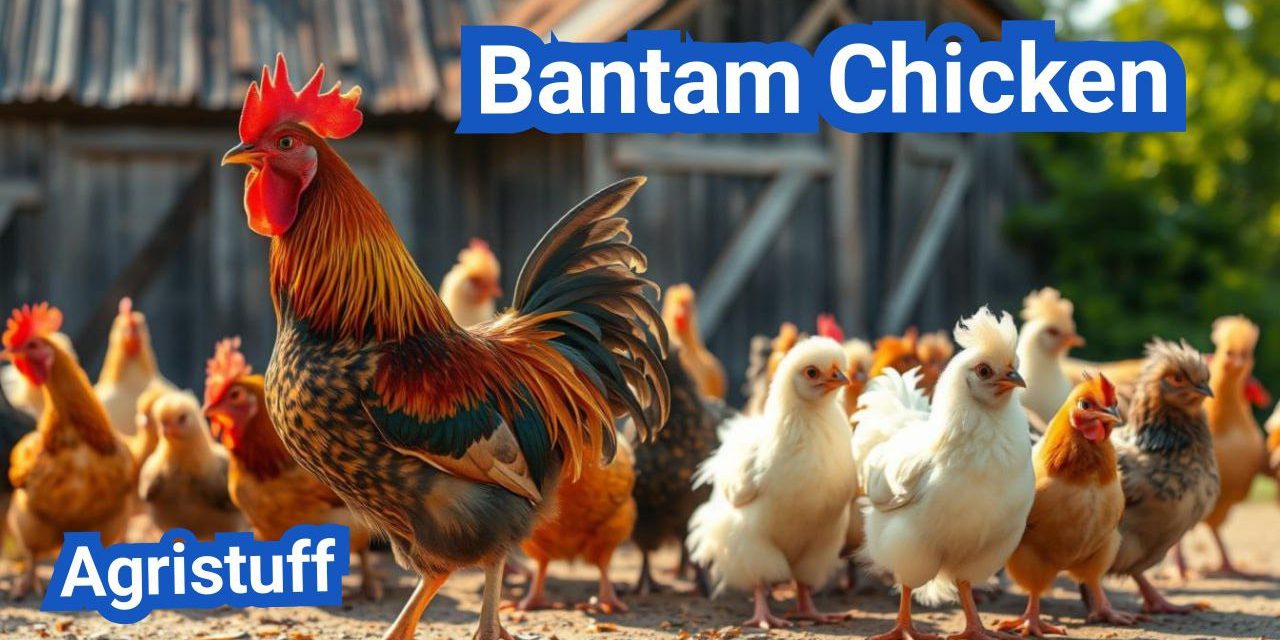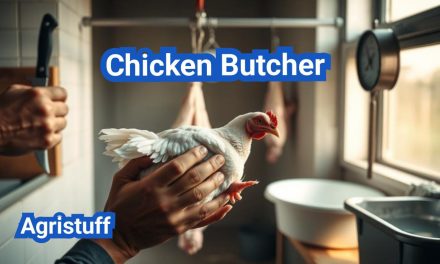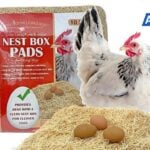Bantam Chickens are miniature versions of regular chickens, often about one-quarter to one-half the size of their standard counterparts. They come in both true bantam breeds and miniaturized versions of standard breeds, offering a wide range of characteristics and traits.
These small chickens are known for their big personalities, making them a popular choice among backyard chicken keepers. With various breeds to choose from, you can select the ones that suit your needs, whether you’re looking for unique bantam chicken eggs or a specific temperament.
The price of bantam chickens can vary depending on the breed and quality, but they generally offer an affordable entry point into backyard chicken keeping.
Key Takeaways
- Discover the unique characteristics of Bantam Chickens
- Explore various bantam chicken breeds
- Learn about bantam chicken eggs and their benefits
- Understand the factors affecting bantam chicken price
- Get an overview of what to expect from keeping bantam chickens
Understanding Bantam Chicken Breeds and Types
Bantam chickens, known for their small size and diverse characteristics, have gained popularity among poultry enthusiasts. Understanding the different types of bantam chicken breeds is essential for anyone looking to add these charming birds to their backyard flock.
Definition and Origin
Bantam chicken breeds can be categorized into three main types: true bantams, miniature bantams, and developed bantams. True bantams are breeds that have no large-fowl counterpart, having been developed in their miniature form. Examples include the Serama and Japanese Bantams.
Miniature bantams are smaller versions of standard chicken breeds. They are bred down from larger breeds to retain the same characteristics but in a compact size. The Silkie Bantam, for instance, is a miniature version of the Silkie chicken.
Developed bantams are breeds that have been developed over time to have distinct features, often combining characteristics from various other breeds. They may not have a direct large-fowl counterpart but are recognized as distinct bantam breeds.
Distinguishing Features
The distinguishing features among bantam breeds lie in their physical characteristics, temperament, and egg-laying abilities. Some key features to consider include:
- Size: Bantams are generally small, with most weighing between 1-2.5 pounds.
- Feathering: Varieties range from smooth-feathered to fluffy and crested.
- Temperament: While some bantams are friendly and docile, others can be feisty.
- Egg Production: Bantams lay smaller eggs compared to standard breeds, but some are prolific layers.
By understanding these differences, backyard chicken keepers can choose the bantam breeds that best suit their needs and preferences.
The Appeal of Raising Bantam Chickens

The appeal of bantam chickens lies in their compact size, low maintenance requirements, and endearing personalities. These characteristics make them an attractive choice for many backyard chicken keepers.
Space Efficiency Benefits
Bantam chickens are ideal for small backyards or urban settings due to their compact size. They require less space to roam and exercise, making them perfect for urban homesteads or small farms.
A key advantage of bantam chickens is that they can thrive in smaller coops and runs, allowing more people to enjoy backyard chicken keeping. This space efficiency is a significant benefit for those living in densely populated areas.
Lower Feed Consumption
Bantam chickens eat less than their standard-sized counterparts, which can lead to significant cost savings over time. This lower feed consumption also results in less waste, making them a more environmentally friendly choice.
The reduced feed requirements of bantam chickens make them an attractive option for those looking to minimize their expenses on chicken feed. This aspect is particularly beneficial for small-scale chicken keepers.
Distinctive Personality Traits
Bantam chickens are known for their friendly and docile nature, making them a great choice for families with children. Many bantam breeds are also known for their unique personalities and characteristics.
The friendly nature of bantam chickens allows them to form strong bonds with their keepers. They are often described as being more personable and interactive than larger chicken breeds.
Family-Friendly Qualities
Bantam chickens are an excellent introduction to chicken keeping for families. Their small size and gentle nature make them a great choice for children to learn about responsibility and animal care.
Many bantam breeds are suitable for families with children due to their calm and friendly demeanor. They are also relatively low maintenance, making them a great starting point for new chicken keepers.
| Benefits | Description |
|---|---|
| Space Efficiency | Bantam chickens require less space, making them ideal for small backyards. |
| Lower Feed Consumption | Eating less than standard-sized chickens, bantams save on feed costs. |
| Distinctive Personality | Bantams are known for their friendly and docile nature. |
| Family-Friendly | Their gentle nature makes bantams a great choice for families with children. |
True Bantams vs. Miniaturized Breeds
When it comes to bantam chickens, there’s a significant difference between true bantams and those that are simply smaller versions of larger breeds. Understanding this distinction is essential for anyone looking to raise these charming birds.
What Makes a True Bantam
True bantams are breeds that have no larger counterpart. They are naturally small chickens that have been bred to retain their miniature size. Examples of true bantams include the Serama and the Japanese Bantam. These breeds have unique characteristics that have been preserved through selective breeding.
Miniaturized Standard Breeds
On the other hand, miniaturized breeds are smaller versions of standard chicken breeds. They are created by breeding larger chickens with smaller ones to achieve a miniature version. For instance, the bantam version of the Plymouth Rock is a miniaturized breed. These chickens retain the characteristics of their larger counterparts but in a smaller package.
American Bantam Association Standards
The American Bantam Association (ABA) sets the standards for bantam breeds in the United States. They define the characteristics, size, and features of recognized bantam breeds. The ABA provides a guide for breeders and enthusiasts to follow, ensuring consistency across the various breeds.
| Characteristics | True Bantams | Miniaturized Breeds |
|---|---|---|
| Origin | Naturally small breeds | Smaller versions of standard breeds |
| Size | Varies by breed, generally small | Proportionate to standard breed size |
| Examples | Serama, Japanese Bantam | Bantam Plymouth Rock, Bantam Brahma |
Popular Bantam Chicken Breeds Guide
Among the many breeds of bantam chickens, some stand out for their popularity and distinct features. Bantam chickens have captured the hearts of many poultry enthusiasts due to their unique characteristics and charm.
Serama Bantams
Serama bantams are one of the smallest chicken breeds in the world, originating from Malaysia. They are known for their upright posture and confident demeanor. Despite their small size, Serama bantams are robust and can be quite friendly, making them a popular choice among bantam enthusiasts.
Silkie Bantams
Silkie bantams are renowned for their fluffy, soft feathers, which give them a unique appearance. They are friendly, outgoing, and often described as having a silky texture to their feathers, hence the name. Silkie bantams are also known for their gentle nature, making them an excellent choice for families.
Sebright Bantams
Sebright bantams are a popular choice due to their laced feathers and vibrant colors. They are known for being active and can be quite entertaining to watch. Sebright bantams are also relatively small, fitting well into the bantam category.
Japanese Bantams (Chabo)
Japanese bantams, also known as Chabo, are admired for their unique appearance and short legs. They come in a variety of colors and are known for their friendly, curious nature. Japanese bantams are a testament to the diversity within the bantam chicken world.
These breeds showcase the diversity and charm of bantam chickens, each with their unique characteristics and appeal. Whether you’re a seasoned poultry keeper or just starting out, these popular bantam breeds are sure to captivate.
Other Notable Bantam Varieties

Beyond the popular breeds, there exist several other notable bantam varieties that are worth exploring. These breeds not only add diversity to your flock but also bring unique characteristics to the table.
Brahma Bantams
Brahma Bantams are known for their impressive size, with some birds weighing up to 38 ounces. Despite their larger size compared to other bantams, they are gentle giants and make great additions to any flock. Their feathering is another notable feature, with a thick, soft coat that requires regular grooming.
Belgian D’Uccle and D’Anvers
Belgian D’Uccle and D’Anvers bantams are recognized for their distinctive bearded and booted features. The D’Uccle has a beard and muffs, while the D’Anvers is known for its large beard. Both breeds are known for their friendly and docile nature, making them a great choice for backyard flocks.
Polish Bantams
Polish Bantams are known for their crested heads, which give them a unique appearance. They come in a variety of colors and are known for their friendly and curious nature. Polish Bantams are relatively small, making them a great choice for smaller backyard flocks.
Old English Game Bantams
Old English Game Bantams are known for their historical significance and are one of the oldest bantam breeds. They are known for their aggressive nature, particularly the roosters, and are often used for cockfighting. However, they can make great pets for experienced owners who are willing to provide the necessary care and attention.
In conclusion, these notable bantam varieties offer a range of characteristics and traits that can add diversity and interest to your flock. Whether you’re looking for a gentle giant like the Brahma Bantam or a historically significant breed like the Old English Game Bantam, there’s a bantam breed out there for everyone.
Bantam Chicken Size and Physical Characteristics
Bantam chickens, despite their miniature size, exhibit a wide range of physical characteristics that make them unique and interesting. These small chickens are not only a delight to behold but also come in a variety of sizes, weights, and feathering patterns.
Average Weight and Height Measurements
Bantam chickens are generally smaller than their standard counterparts, with weights ranging from 1-2 pounds (0.5-1 kg) on average, depending on the breed. Their height can vary significantly, with some breeds standing as low as 6 inches (15 cm) and others reaching up to 12 inches (30 cm) or more.
The weight of bantam chickens is a critical factor in their classification and breeding. Breeders often focus on achieving the ideal weight for specific breeds, which can influence their overall health and competitiveness in shows.
Feathering Patterns and Varieties
One of the most striking features of bantam chickens is their diverse feathering patterns. From the fluffy, soft feathers of Silkie bantams to the sleek, tight feathers of Sebright bantams, the variety is vast. Feathering patterns can include solid colors, mottling, and intricate designs, making each breed distinct.
- Solid colors: black, white, buff, and various shades of red and gold.
- Mottled and speckled patterns: adding visual interest to their plumage.
- Laced and penciled patterns: characteristic of certain breeds like the Sebright.
Comb and Wattle Variations
Bantam chickens also exhibit a range of comb and wattle variations. The comb, which is the fleshy crown on top of a chicken’s head, can be single, rose, pea, or even a combination of types. Wattles, the hanging flaps under the beak, vary in size and color, often correlating with the breed’s overall characteristics.
These variations not only contribute to the aesthetic appeal of bantam chickens but can also be indicators of health and breed purity.
Growth Rate Compared to Standard Breeds
The growth rate of bantam chickens is generally faster than that of standard breeds, proportionate to their adult size. Bantams mature more quickly, often reaching their full size within 16-20 weeks, whereas standard breeds may take longer.
This faster growth rate means that bantam chicken keepers need to be mindful of nutritional needs during the growth phase to ensure healthy development.
All About Bantam Chicken Eggs

Among the many charms of bantam chickens, their eggs stand out for their size, nutritional value, and culinary uses. Bantam chickens, being smaller than standard breeds, lay eggs that are correspondingly smaller, but these eggs are rich in flavor and nutrients.
Egg Size Comparison
Bantam eggs are significantly smaller than those laid by standard chicken breeds. While standard chicken eggs typically weigh around 50-60 grams, bantam eggs usually weigh between 20-40 grams, depending on the breed. For instance, the eggs of Serama bantams are among the smallest, often weighing as little as 15-20 grams.
Egg Production Rates
The rate at which bantam chickens lay eggs varies by breed. Some bantam breeds are prolific layers, producing around 200 eggs per year, while others may lay fewer eggs. For example, Sebright bantams are known to lay around 60-80 small white or tinted eggs annually.
| Breed | Eggs per Year | Egg Size |
|---|---|---|
| Sebright | 60-80 | Small |
| Serama | 100-180 | Very Small |
| Silkie | 100-120 | Small |
Nutritional Value
Despite their smaller size, bantam eggs are nutritionally comparable to standard eggs. They contain proteins, vitamins, and minerals essential for a healthy diet. The yolks of bantam eggs are often more intensely colored, indicating a higher concentration of certain nutrients.
Cooking with Bantam Eggs
Bantam eggs can be used in cooking just like standard eggs. They are ideal for baking, making omelets, or boiling. Due to their smaller size, they are particularly useful for recipes that require multiple eggs, allowing for precise measurement.
Cooking Tip: When using bantam eggs in recipes, remember that several bantam eggs may be needed to replace one standard egg. This can be an advantage in baking, where precision is key.
Setting Up a Proper Bantam Chicken Coop

A well-designed bantam chicken coop is crucial for the health and happiness of your flock. Bantam chickens, despite their small size, require a safe, well-ventilated, and predator-protected environment.
Bantam Chicken Coop Size Requirements
The size of the coop is critical to ensure your bantams have enough space to roost comfortably. A general rule of thumb is to provide at least 2-4 square feet per bantam inside the coop. For example, if you’re keeping 4 bantams, your coop should be at least 8-16 square feet.
Essential Coop Features
Several features are essential for a bantam chicken coop:
- Ventilation: Adequate ventilation is crucial to remove moisture and ammonia from the chickens’ droppings.
- Roosting Bars: Bantams need roosting bars to perch on at night. These should be sturdy and placed higher than the nesting boxes.
- Nesting Boxes: One nesting box per 3-4 hens is recommended. The boxes should be clean, dry, and easily accessible for egg collection.
- Easy Cleaning: A coop design that allows for easy cleaning will make maintenance less of a chore.
Predator Protection Strategies
Protecting your bantams from predators is paramount. Here are some strategies:
- Secure Hardware Cloth: Use hardware cloth with openings of 1/2 inch or smaller to prevent predators from entering.
- Locking Mechanism: Install a secure locking mechanism on the coop door to prevent raccoons and other clever predators from opening it.
- Covered Run: If possible, cover the run with netting or chicken wire to protect from aerial predators.
Nesting Box Design for Bantams
The design of the nesting box is important for encouraging your hens to lay eggs in a safe and clean environment. Consider the following:
- Size: Nesting boxes should be about 12 inches wide, 12 inches deep, and 18 inches tall.
- Comfort: Line the boxes with soft bedding like straw or pine shavings.
- Privacy: Place the nesting boxes in a quiet, dark area of the coop to encourage laying.
By focusing on these aspects, you can create a bantam chicken coop that is both safe and comfortable for your chickens, ensuring they thrive and provide you with fresh eggs.
Complete Bantam Chicken Care Guide

To ensure the well-being of your bantam chickens, it’s essential to understand their specific needs and requirements. Bantam chickens, despite their small size, have unique characteristics that demand particular care and attention.
Daily Maintenance Routine
A daily routine is crucial for maintaining the health and happiness of your bantam chickens. This includes:
- Checking and refreshing their food and water supply
- Cleaning the coop and removing any soiled bedding
- Collecting eggs daily
- Inspecting the chickens for any signs of illness or stress
Ensuring that your bantam chickens have a clean and safe living environment is vital. Regular checks help in early detection of potential issues, allowing for timely intervention.
Seasonal Care Considerations
Bantam chickens require different care during various seasons. For instance:
- In colder months, ensure their coop is well-insulated and draft-free
- Provide extra nutrition during winter to help them stay warm
- In summer, ensure adequate ventilation and shade to prevent heat stress
- Regularly check for and remove any parasites
Seasonal adjustments are crucial for maintaining the health of your bantam chickens. Being proactive about these changes can significantly impact their well-being.
Health Monitoring Practices
Regular health checks are vital for the early detection of diseases. Monitor your bantam chickens for:
- Changes in behavior or appetite
- Signs of illness, such as labored breathing or lethargy
- Visible injuries or parasites
Maintaining a healthy flock requires vigilance and a commitment to providing the best possible care.
Common Health Issues in Bantams
Bantam chickens can be prone to certain health issues, including:
- Respiratory infections
- Parasite infestations
- Egg-related problems
Understanding these potential health issues can help you take preventive measures and seek veterinary care when necessary.
Bantam Chicken Lifespan and Health Factors

The lifespan of bantam chickens, a favorite among backyard poultry keepers, depends on breed, care, and health conditions. Generally, bantam chickens are known to live between 4 to 8 years, with some breeds living longer than others.
Average Lifespan Expectations
The average lifespan of a bantam chicken is influenced by its breed, genetics, and the quality of care it receives. On average, a well-cared-for bantam chicken can live between 5 to 7 years. Some breeds, like the Serama, are known to live up to 8 years or more with proper care.
- Breed: Different breeds have different lifespans.
- Diet: A balanced diet is crucial for longevity.
- Health Conditions: Regular health checks can prevent or manage diseases.
Extending Your Bantam’s Life
To extend the life of your bantam chicken, it’s essential to provide a healthy environment, proper nutrition, and regular health checks. Ensuring their coop is clean, dry, and predator-safe is vital. A balanced diet that includes a mix of grains, proteins, and vitamins is also crucial.
Some key practices to extend their lifespan include:
- Providing a nutritious diet tailored to their needs.
- Ensuring access to clean water at all times.
- Maintaining a clean and safe living environment.
- Regularly checking for signs of illness or stress.
Age-Related Care Adjustments
As bantam chickens age, their care requirements change. Older bantams may need more soft food due to potential dental issues or beak problems. They may also require more frequent checks for health issues such as arthritis or reproductive problems.
Adjusting their care to meet these changing needs can significantly improve their quality of life. This includes:
- Modifying their diet to include softer foods.
- Providing easier access to food and water.
- Ensuring their living space is comfortable and safe.
Feeding Bantam Chickens Properly

The key to raising healthy bantam chickens lies in providing them with a balanced and nutritious diet. Bantam chickens, like their larger counterparts, require a diet rich in essential nutrients to maintain their health, produce eggs, and thrive.
Nutritional Requirements
Bantam chickens have specific nutritional needs that must be met. Their diet should include a mix of proteins, carbohydrates, vitamins, and minerals. Proteins are crucial for growth and egg production, while carbohydrates provide energy. Vitamins and minerals support overall health and immune function.
- Protein content should be around 16-18% for laying hens.
- Calcium is essential for strong eggshell production.
- Vitamin D supports calcium absorption and overall health.
Feed Types and Amounts
The type and amount of feed for bantam chickens depend on their age, size, and purpose (e.g., egg laying or meat production). Starter feed is used for chicks, grower feed for pullets, and layer feed for hens.
- Chicks require starter feed with 20-24% protein.
- Pullets need grower feed with 16-18% protein.
- Laying hens require layer feed with added calcium.
Treats and Supplements
Treats can be given in moderation and should not exceed 10% of their daily diet. Healthy treats include fruits, vegetables, and mealworms. Supplements like grit and oyster shells can support digestive health and eggshell production.
Water Requirements
Access to fresh, clean water is crucial for bantam chickens. Water should be changed regularly to prevent bacterial growth. Ensuring adequate hydration is vital for their overall health and egg production.
In conclusion, feeding bantam chickens properly involves understanding their nutritional requirements, selecting the right feed types and amounts, providing healthy treats and supplements, and ensuring access to clean water. By following these guidelines, you can help your bantam chickens lead healthy and productive lives.
Bantam Roosters: Management and Behavior

Understanding bantam rooster behavior is crucial for harmonious backyard chicken keeping. Bantam roosters, like their larger counterparts, play a significant role in the dynamics of a flock.
Bantam Rooster Temperament
Bantam roosters are known for their bold and sometimes feisty personalities. Their temperament can vary significantly depending on the breed and individual characteristics. Some bantam roosters are friendly and docile, while others may be more aggressive.
Managing bantam roosters effectively requires understanding their temperament and adjusting your care and handling strategies accordingly.
Managing Multiple Roosters
Managing multiple roosters in a single flock can be challenging due to potential conflicts. It’s essential to provide enough space and consider the roosters’ compatibility.
| Factors to Consider | Description |
|---|---|
| Space | Ensure enough space to reduce conflicts |
| Compatibility | Introduce roosters slowly and monitor their behavior |
| Flock Dynamics | Observe how hens interact with multiple roosters |
Noise Considerations
Bantam roosters, like all roosters, are known for their crowing. This can be a consideration for backyard chicken keepers, especially in urban or suburban areas.
- Noise levels can vary between individual roosters
- Some breeds are known to be quieter than others
- Local noise ordinances may restrict rooster keeping
Legal Restrictions for Roosters
Before keeping a bantam rooster, it’s crucial to check local regulations. Some areas have specific laws regarding roosters due to noise concerns.
Key considerations include:
- Checking local ordinances regarding backyard roosters
- Understanding any permits or licenses required
- Being mindful of neighbor relations
In conclusion, managing bantam roosters requires a comprehensive understanding of their behavior, temperament, and the legal and social considerations involved.
Bantam Chickens for Urban Backyards

Bantam chickens are ideal for urban environments, providing companionship and fresh eggs in small spaces. As city dwellers increasingly turn to backyard chicken keeping, bantams stand out as a particularly suitable choice.
City Ordinances and Regulations
Before bringing bantam chickens into your urban backyard, it’s crucial to understand local ordinances and regulations. Many cities have specific rules regarding backyard poultry, including limits on the number of chickens, requirements for coop construction, and rules about roosters. Researching and complying with these regulations is essential to avoid fines and ensure a harmonious experience.
Some cities have more lenient rules, while others may be more restrictive. It’s also worth checking if there are any local chicken-keeping groups or resources that can provide guidance on navigating these regulations.
Neighbor Considerations
Keeping bantam chickens in an urban setting also requires consideration of your neighbors. While bantams are generally quieter than larger breeds, they can still generate some noise, and their presence may not be welcomed by everyone nearby. Engaging with your neighbors before introducing chickens to your backyard can help mitigate potential issues.
Sharing the benefits of backyard chicken keeping, such as fresh eggs and pest control, can help gain neighborly support. Additionally, being mindful of coop placement and maintaining cleanliness can minimize any negative impacts on those around you.
Space-Saving Coop Solutions
One of the advantages of bantam chickens is their compact size, which allows for smaller coops. When designing or selecting a coop for urban backyard keeping, it’s essential to prioritize space efficiency and predator protection. Vertical coops or those with a small footprint can be ideal for tight spaces.
Utilizing recycled materials or DIY coop designs can also be a cost-effective and creative way to provide a safe and comfortable home for your bantams. Ensuring adequate ventilation, protection from the elements, and easy access for cleaning are key considerations.
Noise and Odor Management
Managing noise and odor is critical for maintaining good neighbor relations and ensuring the well-being of both your chickens and your household. Regular coop cleaning, proper waste disposal, and using odor-reducing bedding materials can significantly minimize any unpleasant smells.
For noise management, selecting breeds known for being quieter, such as the Silkie or Serama bantams, can be beneficial. Additionally, providing adequate space and enrichment activities for your chickens can help reduce stress and noise.
Bantam Chicken Economics and Pricing
Bantam chicken economics involves various costs and potential returns. For individuals considering adding these birds to their backyard flock, understanding the financial aspects is crucial.
Initial Investment Costs
The initial investment for bantam chickens includes the cost of the chickens themselves, a coop, and necessary equipment. The price of bantam chickens can vary significantly based on breed, quality, and location.
Initial Costs Breakdown:
| Item | Average Cost | Range |
|---|---|---|
| Bantam Chickens (2-3) | $50 | $20-$100 |
| Coop and Equipment | $200 | $100-$500 |
| Total Initial Investment | $250 | $120-$600 |
Ongoing Maintenance Costs
Ongoing costs include feed, healthcare, and potentially, supplements. The cost of feed is a significant recurring expense, as bantam chickens require a balanced diet to stay healthy.
Ongoing Costs Breakdown:
| Expense | Monthly Cost | Annual Cost |
|---|---|---|
| Feed | $15 | $180 |
| Healthcare and Supplements | $5 | $60 |
| Total Ongoing Costs | $20 | $240 |
Return on Investment Potential
Bantam chickens can provide a return on investment through the sale of eggs and potentially, breeding stock. The value of this return depends on the breed, egg production rate, and market demand.
Selling Bantams and Eggs
Selling bantams and their eggs can help offset the costs of maintaining them. Breeding and selling bantam chickens can also be a profitable venture for those with the necessary expertise and resources.
By understanding the economics of bantam chickens, potential owners can make informed decisions about whether keeping these birds is right for them.
Is a Bantam Chicken Right for You?
Bantam chickens can be a delightful addition to many backyards, offering unique benefits and joys. They are suitable for a variety of keepers, from beginners to experienced poultry enthusiasts. When considering keeping bantam chickens, it’s essential to assess your ability to provide the necessary care and attention.
These small chickens require a suitable coop, proper nutrition, and regular health checks. If you’re willing to invest time and resources, bantam chickens can thrive under your care. Their small size and relatively low maintenance make them an attractive option for urban backyards or small farms.
Before deciding to bring bantam chickens into your life, evaluate your local regulations and neighborhood dynamics. Ensuring that you can provide a safe and healthy environment is crucial for the well-being of both your chickens and your community.
Ultimately, keeping bantam chickens can be a rewarding experience, offering fresh eggs, entertainment, and a connection to nature. If you’re considering adding bantam chickens to your family, assess your bantam chicken suitability by weighing the benefits and responsibilities involved.
FAQ
What is a Bantam Chicken?
Bantam Chickens are a group of chicken breeds that are characterized by their small size. They can be either true bantams, which are naturally small, or miniature versions of larger chicken breeds.
What are the benefits of raising Bantam Chickens?
Raising Bantam Chickens offers several benefits, including space efficiency, lower feed consumption, and their friendly personalities, making them suitable for families and urban backyards.
How big are Bantam Chickens?
Bantam Chickens are significantly smaller than standard chicken breeds, with most weighing between 1-2 pounds and standing about 6-10 inches tall.
What is the difference between true bantams and miniaturized breeds?
True bantams are naturally small chicken breeds that have not been miniaturized from larger breeds. Miniaturized breeds, on the other hand, are smaller versions of larger chicken breeds.
How many eggs do Bantam Chickens lay?
Bantam Chickens lay smaller eggs than standard breeds, but their egg production rates vary by breed. On average, a Bantam Chicken can lay around 100-200 eggs per year.
What are the most popular Bantam Chicken breeds?
Some of the most popular Bantam Chicken breeds include Serama, Silkie, Sebright, Japanese Bantams, Brahma, Belgian D’Uccle, Polish, and Old English Game Bantams.
How do I care for Bantam Chickens?
Caring for Bantam Chickens involves providing a proper coop, daily maintenance, seasonal care, health monitoring, and a balanced diet. They require regular checks for health issues and a clean living environment.
What is the lifespan of a Bantam Chicken?
The average lifespan of a Bantam Chicken is around 5-7 years, but with proper care and management, some can live up to 10 years or more.
Can I keep Bantam Roosters with hens?
Yes, you can keep Bantam Roosters with hens, but it’s essential to manage their behavior, ensure enough space, and be aware of local regulations regarding roosters.
Are Bantam Chickens suitable for urban backyards?
Yes, Bantam Chickens are suitable for urban backyards due to their small size, lower noise levels, and minimal space requirements. However, it’s crucial to check local ordinances and regulations.
How much do Bantam Chickens cost?
The cost of Bantam Chickens varies depending on the breed, age, and quality. Initial costs include purchasing the chickens and setting up a coop, while ongoing expenses include feed, healthcare, and supplies.
Can I sell Bantam Chickens and their eggs?
Yes, you can sell Bantam Chickens and their eggs, but be sure to check local regulations and ensure you are complying with any necessary health and safety standards.
Conclusion of: Bantam Chicken
Bantam Chicken fans love that a Bantam Chicken brings full-size charm in a pint-size package, making it perfect for backyards, urban homesteads, and children learning poultry care. A Bantam Chicken typically weighs far less than standard birds yet offers lively behavior, manageable space needs, and surprising productivity for its size—exactly why a Bantam Chicken has become a favorite across the USA.
Learn more about backyard poultry from the USDA.
What Is a Bantam Chicken?
A Bantam Chicken is a miniature chicken—either a scaled-down version of a large breed or a naturally small “true” variety—and every Bantam Chicken keeps the same basic chicken instincts, flock dynamics, and care needs in a smaller body. Because a Bantam Chicken eats less and needs less room, many first-time keepers choose a Bantam Chicken to start a backyard flock.
Explore poultry care basics from Purdue Extension.
Types of Bantam Chicken: True, Miniaturized, and Developed
A Bantam Chicken falls into three broad types that help you set expectations for size, temperament, and show standards. A “true” Bantam Chicken has no large-fowl counterpart (think Sebright, Dutch, Nankin, Serama, or Japanese Bantam), while a miniaturized Bantam Chicken is a small version of a known large breed (like Cochin, Orpington, or Plymouth Rock). You’ll also see “developed” Bantam Chicken lines created over time for ornamental qualities, and each type of Bantam Chicken can suit different goals.
Discover breed classifications from the American Poultry Association.
Why Choose a Bantam Chicken for Backyard Flocks?
A Bantam Chicken fits beautifully into small spaces, uses less feed, and is easier for kids to handle, which lowers barriers for new keepers. A Bantam Chicken also offers rich variety—hundreds of recognized breeds and color varieties exist—so your Bantam Chicken can be functional, ornamental, or both. For many owners, a Bantam Chicken is also quieter than a large rooster, though any Bantam Chicken rooster will still crow and needs to meet local rules.
Read urban poultry guidelines from Penn State Extension.
Popular Bantam Chicken Breeds and What They’re Like
A Bantam Chicken can be fluffy, sleek, or dramatically laced depending on breed, so match your Bantam Chicken to your goals. A Silkie Bantam Chicken is famously gentle and broody, a Sebright Bantam Chicken is an eye-catching, “hen-feathered” true bantam, and a Serama Bantam Chicken is one of the smallest with a proud, upright stance. A Japanese Bantam Chicken (Chabo) shows very short legs and a tall tail, and a Cochin Bantam Chicken (often called “Pekin” in some countries) is a feather-legged, cuddly mini.
See breed profiles from the American Bantam Association.
Size and Weight: How Small Is a Bantam Chicken?
A Bantam Chicken varies by breed, but most weigh well under the heft of large-fowl birds, often around a pound or two. A Serama Bantam Chicken can be just a few ounces in some show classes, while a Cochin Bantam Chicken or Brahma Bantam Chicken is bigger but still compact. For planning, assume each Bantam Chicken will need less feed and space than standards, yet remember that every Bantam Chicken still requires good husbandry to thrive.
Review space requirements from the University of Minnesota Extension.
Egg Production: What to Expect From a Bantam Chicken
A Bantam Chicken lays smaller eggs, but a healthy laying Bantam Chicken can still supply a family kitchen with frequent eggs depending on breed and season. A Sebright Bantam Chicken lays modestly, a Silkie Bantam Chicken often prioritizes brooding over laying, and a Dutch or Belgian-type Bantam Chicken may lay more consistently. In baking, a Bantam Chicken egg is small, so many cooks use multiple Bantam Chicken eggs or measure by volume; either way, a Bantam Chicken can keep you stocked for breakfasts and light recipes.
Learn about egg sizes from the FDA.
Do Bantam Chicken Eggs Taste Different?
A Bantam Chicken egg tastes like any other fresh egg—diet and freshness drive flavor more than size—so a Bantam Chicken fed a balanced ration produces excellent eggs. Because a Bantam Chicken egg is smaller, you may use an extra Bantam Chicken egg in recipes or crack eggs into a measuring cup to match the volume of a large egg. In daily cooking, a Bantam Chicken egg works perfectly for scrambles, omelets, and snacks.
Compare egg nutrition from Harvard T.H. Chan School of Public Health.
Temperament: The Personality of a Bantam Chicken
A Bantam Chicken is often an enthusiastic, people-friendly bird, which is why a Bantam Chicken is common in youth poultry programs and 4-H. While individuals vary, a Bantam Chicken tends to be easy to handle, curious, and active, and many keepers describe their Bantam Chicken as a “lap chicken.” If your goal is a child-friendly bird, a Silkie Bantam Chicken or Cochin Bantam Chicken is typically gentle, whereas a game-type Bantam Chicken may be more energetic.
Explore 4-H poultry projects from 4-H.org.
Broodiness and Mothering: A Bantam Chicken as a Natural Incubator
A Bantam Chicken, particularly many true bantams and Silkies, is famously broody and will sit on eggs with dedication, making a Bantam Chicken a reliable mother for hatching. This makes a Bantam Chicken valuable even in mixed flocks where you want natural hatching without an incubator. If you don’t want chicks, collect eggs promptly and have a plan to “break” broodiness humanely when a Bantam Chicken insists on setting.
Learn about broody hen management from Mississippi State University Extension
Housing and Space: Setting Up a Home for a Bantam Chicken
A Bantam Chicken needs a dry, draft-free, well-ventilated coop with predator-proof hardware cloth and secure latches. Compared to standards, each Bantam Chicken can live comfortably in less floor space, but don’t overcrowd; many keepers allocate 1-3 square feet per Bantam Chicken in the coop and more in the run, with extra room improving health and behavior. For perches, a Bantam Chicken does best with lower roosts so the smaller body isn’t injured jumping down, and every Bantam Chicken appreciates wide, easy-grip roosts.
Find coop design recommendations from the University of Florida IFAS Extension
Run and Enrichment: Keeping a Bantam Chicken Busy and Safe
A Bantam Chicken is agile and can slip through gaps, so build a tight-mesh, covered run to keep hawks and neighborhood cats out and your Bantam Chicken in. Enrich the run so a Bantam Chicken can dust-bathe, scratch, and perch; this reduces boredom and pecking. Because a Bantam Chicken may fly better than heavy breeds, clip one wing if needed and always supervise free-ranging where predators are common.
Read about poultry predator protection from USDA National Agricultural Library
Feeding and Nutrition: Right Diet for a Bantam Chicken
A Bantam Chicken thrives on a complete ration—starter for chicks, grower for adolescents, and layer feed with proper calcium once hens begin laying. Treats should stay under 10% of intake for a Bantam Chicken to avoid nutrient dilution and obesity. Grit and fresh water must be available at all times for a Bantam Chicken, and in cold weather a Bantam Chicken benefits from unfrozen water and steady access to feed.
Understand poultry nutrition from Virginia Cooperative Extension
Health, Biosecurity, and Climate: Keeping a Bantam Chicken Well
A Bantam Chicken is hardy when well-kept but can lose body heat faster due to size, so insulate against drafts while maintaining ventilation. In heat, a Bantam Chicken needs shade and cool water; in cold snaps, a Bantam Chicken appreciates dry bedding and wind breaks rather than sealed coops that trap moisture. Quarantine new birds before mixing and keep a basic kit so any Bantam Chicken with minor injuries or mites can be treated promptly.
Learn poultry health basics from Iowa State University Extension
Showing and Standards: Where a Bantam Chicken Shines
A Bantam Chicken dominates many shows because a Bantam Chicken is easier to transport and handle, and breed clubs publish detailed standards. If exhibition interests you, select a Bantam Chicken from lines bred to standard, learn the correct combs, colors, and feathering, and practice calm handling so your Bantam Chicken poses well. Youth exhibitors often start with a Bantam Chicken because the experience is rewarding and manageable.
Explore poultry show standards from the American Bantam Association
City Rules and Roosters: What Every Bantam Chicken Keeper Should Check
A Bantam Chicken is welcomed in many towns, yet rules vary widely, so verify local ordinances before you bring home a Bantam Chicken. Many cities allow hens but not roosters because even a Bantam Chicken rooster crows, and setbacks, permits, and flock size caps may apply. Good neighbor etiquette—clean coops, odor control, and quiet routines—helps every Bantam Chicken flock stay welcome.
Check urban poultry regulations from National Association of Counties
Choosing the Right Bantam Chicken for You
A Bantam Chicken choice depends on goals: for gentle pets and brooding, consider a Silkie Bantam Chicken; for show-stopping looks, a Sebright Bantam Chicken dazzles; for the tiniest birds, a Serama Bantam Chicken fits the bill; for cold-tolerant fluff, a Cochin Bantam Chicken is a classic. If you want more eggs, select a productive Bantam Chicken strain and manage lighting, nutrition, and predator safety. With a bit of planning, your Bantam Chicken can deliver daily joy, education, and farm-fresh eggs.
Find breed selection guidance from University of Illinois Extension
Getting Started Checklist for Your First Bantam Chicken
A Bantam Chicken starter plan keeps you organized: confirm local rules, then order healthy chicks or started birds from reputable sources suited to your climate. Prepare the brooder or coop before your Bantam Chicken arrives—heat for chicks, secure fencing, clean bedding, and the correct feed. Schedule time for daily care and handling so your Bantam Chicken bonds with you and settles into a predictable, low-stress routine.
Access poultry starter checklists from Ohio State University Extension
Common Questions People Ask About Bantam Chicken
A Bantam Chicken often raises the same questions: Do you need a rooster for eggs? No—any Bantam Chicken hen lays without a rooster, though a rooster is needed for fertile eggs. Will a Bantam Chicken mix with large birds? Yes, but watch pecking order and provide multiple feeders so each Bantam Chicken eats in peace. Can a Bantam Chicken live entirely indoors? A Bantam Chicken needs outdoor time, fresh air, and sunlight, even if supervised in a small yard or secure run.
Read poultry FAQs from University of California Agriculture and Natural Resources
Final Thought
A Bantam Chicken proves that small really can be mighty—compact, charismatic, and capable of eggs, companionship, and even show ribbons. With thoughtful housing, balanced feed, and a bit of training, your Bantam Chicken will reward you with daily entertainment and confident foraging in a small footprint. Whether you want a gentle child-friendly pet, a decorative showpiece, or a hardworking little layer, a Bantam Chicken brings outsized value to any American backyard.
Discover more about small flock management from USDA National Institute of Food and Agriculture













